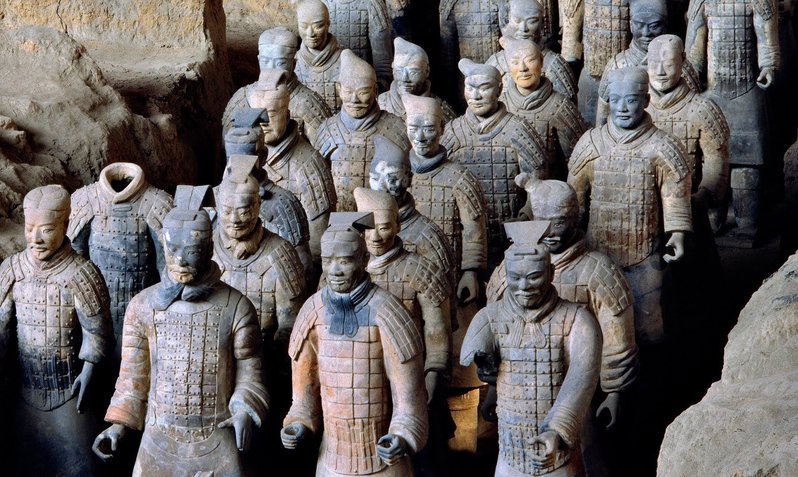Welcome to Xi'an. Today we're going to visit the Museum of Terra Cotta Warriors and horses of Qin Shihuang, who was the first emperor in Chinese history, a remarkable historical figure and a cruel autocrat. According to the historical record, at the age of 13, Qin shihuang began to build his mausoleum, which lasted for as long as 38 years and involved the hard labor of more than 720,000 people.
In April 1974, peasants digging a well about 1.5 kilometers east of Qin Shihuang's mausoleum happened to discover one of the greatest archaeological sites in the world. Excavation of three underground pits revealed 8000 terracotta warriors and horses in battle formation. The discovery amazed the whole world, which resulted in the building of the museum on the original archaeological site.
Now, ladies and gentlemen, first please follow me to No.1 Pit to witness this wonder of the world with your own eyes. Being the largest of the three, No. 1 Pit hosts the main body of the Qin Shihuang's underground army, with about 6,000 life-size terracotta warriors and horses in an area of 14,260 square meters. Carefully sculpted and individually differentiated, these thousands of life-sized terra cotta warriors and horses were arrayed according to the Qin Dynasty's battle formation. Please look at the three rows of 210 soldiers who stand at the easternmost end of the army. They served as vanguards of the troop.Close behind is the main force of armored soldiers accompanied by 35 horse-drawn chariots. These warriors, facing north, south, and west respectively, occupy the outermost rows and they are probably the flanks and the rear guards. Ladies and gentlemen, if we look at those soldiers closely, it’s easy to find that every figure differs from those around in facial features, clothing, hairstyle, and gestures. What’s more, the horsemen, the longbow bearers, the archers and the senior officers were positioned in strict accordance with the ancient directives on the Art of War.
Ladies and gentlemen, we are now arriving at the exhibition hall of bronze chariots. In December 1980, two sets of large painted bronze chariots were unearthed 20 meters west of Emperor Qin Shihuang’s Mausoluem. The bronze chariots, drawn by four horses, with a single shaft, were placed one in front of the other. The front chariot was also called the high chariot and the back chariot was called security chariot. Being a symbol of Qin Shihuang's guard of honor, the two chariots are the largest in size and the most exquisite in workmanship ever found in the world. Dear friends, please look at the high chariot. It was equipped with crossbows, arrow heads, shields because it was used to protect the security chariots in which Qin Shihuang sat. The security chariot was fitted with more than 1500 pieces of gold , silver and other ornaments, looking luxurious, splendid and graceful.
The Museum is like a treasure house of Qin Dynasty's military affairs, science and technology, art and culture. It displays brilliant and profound Chinese civilizations with its exquisite cultural relics to the world. It has been listed as an UNESCO World Heritage Site. After visiting the museum, Jacques Rene Chirac, ex-president of France, praised it to be the eighth wonder of the world . Dear visitors, in front of these treasures, do you feel deep esteem towards the great creation and wisdom of Chinese ancestors?



